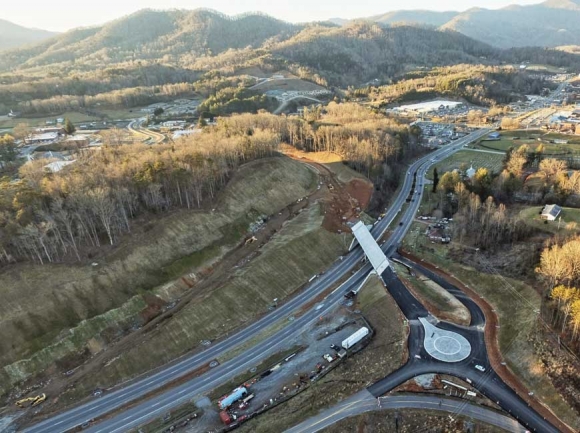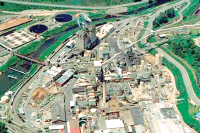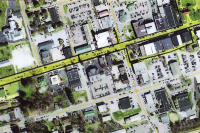SCC sues DOT, construction company over damaged building
 The $30 million R-5000 road project resulted in a 0.7-mile road connecting N.C. 107 and N.C. 116 alongside Southwestern Community College’s campus. A Shot Above WNC photo
The $30 million R-5000 road project resulted in a 0.7-mile road connecting N.C. 107 and N.C. 116 alongside Southwestern Community College’s campus. A Shot Above WNC photo
Southwestern Community College is seeking compensation for damage to the Balsam Center building that it believes resulted from the R-5000 road project, a 0.7-mile connector road between N.C. 107 and N.C. 116 that wound up costing $30 million.
A three-way finger-pointing contest over the damage has been ongoing since 2015, with SCC blaming DeVere Construction Company Inc. and the N.C. Department of Transportation, and DeVere and the DOT each claiming that the other is responsible for the mess.
That saga continues with a pair of lawsuits that the SCC trustees filed in December. In the lawsuits — one against DOT and another against DeVere — SCC claims that DeVere was negligent in its construction practices, resulting in damage to the building, and that underground anchors associated with the project extended beyond the DOT’s right-of-way, amounting to an uncompensated taking of property. In each suit, SCC is seeking damages in excess of $10,000, with the exact amount to be decided following a jury trial.
In the suits, SCC claims that DOT’s construction easement for the culvert project associated with the R-5000 project was limited to the Balsam Center parking lot, but that the easement stopped at the concrete sidewalk in front of the building. However, the suits say, when DeVere installed helical anchors to secure metal sheeting for the project, those anchors extended under the Balsam Center’s foundation. In January 2015, the suits say, DeVere began removing the metal sheeting and the helical anchors, but no fill or grout was placed in the holes created when those anchors came out. This caused holes in the ground under the building’s foundation. As a result, the suit said, vertical and horizontal cracks appeared in the Balsam Center’s interior and exterior walls and floors.
“Due to NCDOT’s and DeVere’s actions and/or omissions stated above, the subsurface soil underneath the Balsam Center Building’s foundation was disturbed and compromised, leading to soil settlement and shifting underneath the Balsam Center Building and is the direct and proximate cause of the Balsam Center Building’s settlement-related damages,” both suits read.
SCC claims that DeVere failed to adhere to its own plans and specifications, charging the company with negligence and trespass to real property. In its complaint against the DOT, SCC further states that a copy of a subsurface report commissioned for the project, which DOT received in September 2012, was not shared with SCC. It also claims that the alleged trespass of the helical anchors outside the project right-of-way amounts to taking of a “compensable interest” of SCC’s property and that SCC is due compensation for this taking, as well as recovery of court, attorney, appraisal and engineering fees.
Related Items
In its response to the lawsuit filed March 8, DeVere denied many of the central claims in SCC’s complaint. DeVere denied the assertion that the right-of way was limited to the parking lot area, as well as the claims that no fill or grout was placed in the holes when the anchors were removed, that DeVere did not use proper desaturation protocol, that DeVere failed to adhere to its own plans and specifications and that damage to the Balsam Center Building was the result of DeVere’s negligence.
The DOT approved all of the construction plans, DeVere said, and any damages that occurred “were caused by defects in the plans and specifications provided by NCDOT and were not caused by DeVere.” In addition, the company said, because it did its work in accordance with the specifications from DOT, it can’t be held liable for any damages resulting from performance of that work. If damage did result from the work, the response said, SCC should seek compensation by suing DOT for compensation for property taken — which, as it happens, SCC is doing.
DeVere further expounded on its complaints against DOT in a third-party lawsuit attached to its response, bringing in the DOT, CALYX Engineers and Consultants Inc. and engineer Dave Wissell as third-party plaintiffs in the case.
According to this complaint, the DOT and the engineering firm CALYX knew or should have known about saturated soils and subsurface water under the Balsam Center. These entities “were negligent and breached their duties of care owed to the College by preparing drawings, plans and specifications that were defective, and those defects were the proximate cause of any property damage alleged by the College,” DeVere said. The plans were defective, DeVere said, because they required stone to be placed around the subgrade culvert, which would have allowed water to migrate from the Balsam Center’s foundation, creating voids underneath and causing the building to settle.
DeVere also pointed the finger at engineer Dave Wissell, who it says designed the temporary shoring that SCC alleges ultimately created the problems, saying that the “alleged but denied property damage arises from and relates to the acts and/or omissions of Wissell.” DeVere states that its agreement with Wissell included a provision that Wissell would reimburse DeVere for any costs it should be required to pay for settling claims related to the work.
DeVere closed by asking that SCC’s claims against it be dismissed and that any costs or liability associated with the case by covered by DOT, CALYX and Wissell.
DOT has not yet filed a response to either SCC’s lawsuit or DeVere’s third-party complaint. When asked about the case, a DOT spokesman said that the department has a policy against commenting on ongoing lawsuits.
“CALYX was only recently added to the lawsuit by DeVere, and as such, it is too soon to offer any detailed response,” said Candace Austin, communications manager for CALYX. “Based on what we know at this time, CALYX strongly denies any and all liability in this matter.”
A request for comment sent to Wissell was not immediately returned.
This is not the first time that DOT and DeVere have been at loggerheads. In January 2016, the company walked away from DOT projects across the state, including its $15.9 million contract for the R-5000 project. Despite warnings from the DOT, DeVere defaulted on the project, initiating a bonding procedure that resulted in DeVere’s bonding agency, Liberty Mutual, suing the company in federal court. Liberty sued the company for $12.5 million, saying that it had “willfully breached” its duty to Liberty in the way it spent funds from the bonding company, and that DeVere “intentionally submitted false, misleading and/or inaccurate information contained in the financial statements submitted to Liberty.”
For example, said Liberty, financial statements submitted in 2013 to assure Liberty that there was enough collateral to protect Liberty from harm claimed more than $20 million in total assets, but when the statements were resubmitted two years later they reported just about $7.5 million in total assets. DeVere, meanwhile, blamed its problems on a “cash flow issue caused by the North Carolina Department of Transportation’s intentional and improper failure to timely pay DeVere for projects it had completed.”
The case was dismissed in August 2017, but the claims themselves were not resolved. U.S. District Judge Thomas L. Ludington wrote that the case was dismissed because the individuals named in the lawsuit had entered bankruptcy, so proceedings against those defendants were administratively stayed.
“But the complaint includes a number of unresolved claims against the company Defendants (DeVere),” Ludington wrote. “Proceedings related to those were not stayed because those Defendants have not entered bankruptcy.”
The case was dismissed without prejudice, meaning that it could be re-filed at some point in the future.









